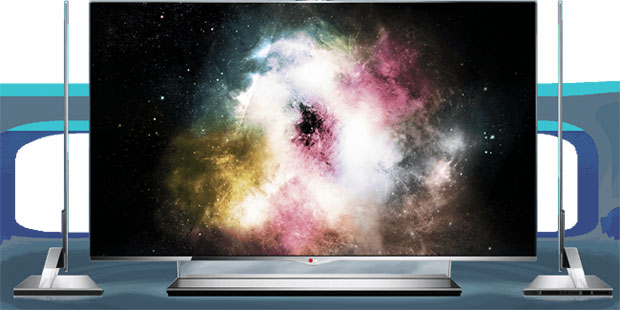
The 2013 International CES is in full swing, and it’s easy to get caught up in all the hoopla over the latest and greatest tech gizmos on display. However, this is a cycle that repeats itself annually, and what’s hot in Vegas this week may cool down faster than you can say “OLED.”
A year ago, OLED (organic light emitting diode) — the latest development in LED technology — was the eye-catching, head turning TV innovation that was all the rage at CES. It promised sets that were thinner, lighter and brighter.

Several companies, including thetwo largest producers of HDTV sets, South Korea-based Samung and LG, were on board to roll out ultra-thin OLED models, which were set to arrive with ultra-high prices.
That was then, this is now. OLED doesn’t appear to have much star power at CES this year, and its futureseems to have dimmed. In October, Samsung announced itwas pushing back its release of OLED panels until the new year. InDecember, reports circulated that both Samsung and LG were consideringshelving the technology for the near future.
LG decided to move forward,with its first OLED model scheduled to ship in South Korea in February. It will debut in the U.S. in March, with sets selling for around US$12,000.
Despite LG’s news, OLED volumes are expected to be low, while prices are expected to bevery high, NPD Group DisplaySearch noted in a recent forecast.
Consumers Tuning Out
With fiscal cliff worries, a continuing sluggish economy, and falling priceson current sets, it wasn’t hard to see that trying to market a newTV technology was going to be a hard sell at the end of 2012. ManyHDTV sets in reasonably large sizes — 50-inches and greater — were selling for$1,000 or less in the lead-up to the holiday season. It seemed apparent that the prospect of OLEDin the wings wasn’t attractive enough to induce consumers to wait.
“That is a pretty reasonable take on the state of the display market,” saidBen Arnold, director of industry analysis at the NPD Group. “Consumersprocess this stuff at a fairly basic level.”
The biggest selling point of OLED TVs today is their thinness. They’reoften just an inch or so, compared to the three or so inches of most rivalplasma and LCD technologies.
OLED’s Other Advantages
The thin factor isn’t the only advantage of OLED, but the other things it offersaren’t likely to convince consumers to spend upwards of $10,000.
“We can talk about lighting and resolution, but consumers make up their mindon what TV is best for them based on a few criteria: size, brand and which looks the best to them in the store. That guides the preference more than anything,” Arnold told TechNewsWorld.
“OLED has super thinness and energy savings,” added Arnold. “All that stuff isgreat for journalists and analysts to talk about. But consumers goingto retail [stores] aren’t going to care as much. What is impactful is how the set’spicture looks.”
OLED does have superior contrast over competing technologies, but again,probably not enough to get the consumer on a budget to break the bank tobuy it — and the thin factor only goes so far.
“There is a point where it doesn’t really matter,” Arnold emphasized. “Idon’t know if we are at that threshold or not.”
OLED’s Technology Troubles
The OLED technology will not be able to fall in price as quickly ascompeting technologies — notably plasma or even LED — simply becauseit is a hard panel to produce.
OLED technology has a serious production flaw that results in just 10percent of large panels — 50 inches and greater — passing testsduring manufacturing. Even after repairs and electronic tweaks, this numberis only increased to 30 percent of panels that make it into finished TVsets.
This could be one reason the two largest TV manufacturers — theformat’s largest supporters so far — could be having second thoughts, at least whenit comes to TVs.
“Samsung and LG have jumped ship on OLED,” said Chris Boylan, editor ofBig Picture Big Sound.
“Samsung has a huge AMOLED business for smaller screens — phones and tablets — which could stilltranslate into larger screen sizes, but problems with the yield or success rate oflarger OLED panels using the current OLED fabrication techniques areplaguing both manufacturers,” he explained.
“They’re not getting as many usable panels as they would like out of eachbatch, which raises the overall costs,” Boylan told TechNewsWorld. “Thepicture quality benefits of OLED over LED/LCD technology — and even plasma –are significant, but the costs are currently so much higher than LED/LCDand plasma sets that it just isn’t cost-effective to release OLED TVs giventhe current market conditions.”
That doesn’t mean either is out of the game yet.
Japanese Resurgence
However, the future of OLED could depend not on the Korean TV makers, but on theirJapanese rivals. Many Japanese companies are looking for a way to takeback their long-held dominance in the TV market.
“There are alternative printing-based manufacturing methods to make OLEDpanels which could make OLED TV production not only viable, but cheaper byan order of magnitude from the current process,” added Boylan.
“Panasonicand Sony recently partnered on OLED manufacturing R&D,” he noted.
“There is an outside chance that the Japanese manufacturers may makebreakthroughs that would allow them to leapfrog past the Koreans in largescreen OLED technology, but this is a really big ‘if,'” Boylan said. “CES 2013may be too early for the manufacturers to be able to show anything alongthese lines.”
Rival Technologies Could Delay OLED
The other problem is that a year ago, OLED was on the forefront of being the”next big thing,” but now rival technologies are capturing interest. One inparticular is standing out, and that is 4K — recently dubbed “Ultra HD.”
At present the two technologies exist in parallel development.
“OLED and 4K TVs both have advantages over current technologies,” said TomMorrod, senior principal analyst of TV systems and technology at IHSiSuppli. “Makers of those will have opportunities to make revenue overcurrent technologies.”
However the two technologies are not compatible. The Ultra HD sets offerthe promise of much greater resolution than current HDTV. With four timesthe pixels, these sets could usher in even larger sets, but given thatOLED’s makers have had a hard enough time developing 50- to 65-inch panels,going even bigger is only going to exacerbate the problem. Still, OLED’s thinner sets could be the future of 4K/Ultra HD in the long term.
“At present, these two technologies are not compatible,” said Arnold, “butthe two technologies will be in parallel development for the next five orsix years and could eventually come together.”
In other words, the future could be an Ultra HD OLED set, but it will require a little — or perhaps more — patience. Perhaps it will be something for the2016 International CES.





















































